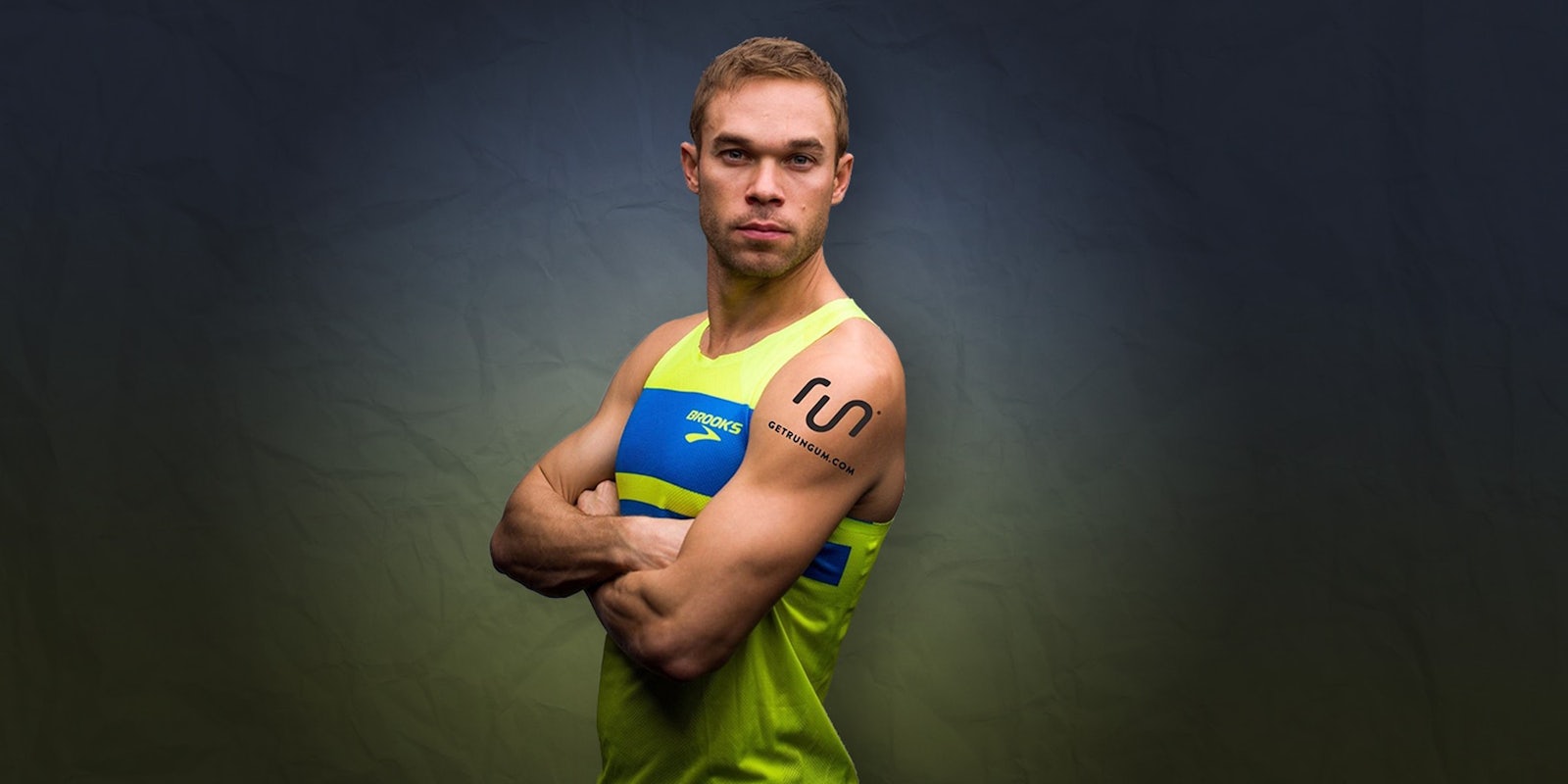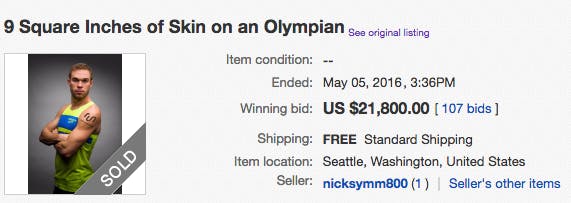Track and field star Nick Symmonds is currently training for the 2016 Olympics in Brazil, but he has an even bigger showdown on the horizon.
The two-time Olympian just sold ad space on his arm on eBay to raise awareness about the outdated rules imposed on athletes.
Early this month, Symmonds’ headline-grabbing auction for nine square inches of real estate on his right shoulder earned $21,800—nearly double what he earned when he pulled the same stunt in 2012. Then, he sold the space to advertising agency Hanson Dodge Creative for $11,000.
Symmonds’ history of selling ad space on himself has made him into a rebellious figure in the track and field community. Fittingly, this year’s auction—which will tentatively encompass six events, including the USA Olympic Trials and 2016 Olympic Games in Brazil, assuming Symmonds qualifies—was won by another person with a history of saber rattling in his own field: T-Mobile CEO John Legere.
True to his typical habits of poking the bears of the telecommunications industry, Legere has already suggested tattooing Symmonds with a message of “F^@% AT&T” at the insistence of his Twitter followers, who weighed in on a poll.
Now that I’ve purchased a spot on 2x Olympian, @NickSymmonds’ arm, help me decide what the tattoo should be of! GO!
— John Legere (@JohnLegere) May 6, 2016
The message is fitting for Symmonds who has a similar, albeit more refined sentiment when it comes to his attitude toward the bodies that govern Olympic competitions.
“I want to raise awareness about the fact that our Olympians don’t get paid a single dollar from the IOC [International Olympic Committee] to compete,” Symmonds told the Daily Dot. “This current model, that has all of the money passing through IOC and absolutely none of it going to the athletes, is unacceptable.”
“My running needs to be about more than just me running around in circles.”
Symmonds isn’t exaggerating: While it’s not uncommon to see massive, multimillion dollar contracts for athletes playing in professional leagues, Olympians are still expected to operate under the guise of amateurism and aren’t paid for their efforts.
For a period of time, the Olympics truly were all about amateurs from around the world competing, a guiding principle installed by Pierre de Coubertin, the founder of the IOC and father of the modern Olympics.
The IOC went out of its way to ensure the purity of the games, going so far as to strip American athlete Jim Thorpe of his gold medals in the decathlon and pentathlon during the 1912 Olympics because he had once accepted money to play semi-professional baseball. (His accomplishments were later reinstated in 1983, 30 years after his death.)
But the notion that today’s athletes competing in the Olympics aren’t professionals is misguided; the curtain that separated the amateurs from the pros was pulled back in 1986 and made way for superstar squads like the United States’ Dream Team, which represented the country in basketball in 1992.
Symmonds explained the shift was an adaptive measure by the Olympics to bring in the increasing fan bases of professional athletes, which brought with it an increased amount of sponsorship cash as advertisers knew there would be more eyes on the games.
The shift to open the doors to professional competitors changed the shape of the Olympics in many ways, except for one very important one: “They never bothered to share that [money] with the athletes who created that value,” Symmonds explained. “It’s an indentured servant system where the athletes are compensated nothing and expected to do their job for free just to pad the pockets of the IOC.”
His primary call is for a revenue sharing model—a 50/50 split, to be exact—that will put cash into the hands of athletes who have made the games into a worldwide attraction. But even before that, he wants to encourage athletes to take control of their bodies with his Own Your Skin movement, which he led by example with his advertisement auction. The IOC generated over $8 billion during its last four-year cycle ending with the London Olympics in 2012, and it’s poised to make even more going forward thanks to extended television and media contracts.
Since there is no money coming from the organization that controls the competition, athletes have to count on other means to make a living while training. In some cases, countries provide a salary for their athletes to afford them the opportunity to train and focus on their sport.
The United States doesn’t operate under this system; instead, athletes have to court sponsorship money to keep them afloat during the excruciating process of perfecting their performance to a world-class level. Due to this lack of funding, some professional track athletes make as little as $5,000 per year.
“Without corporate support, our Olympians don’t get to train,” Symmonds said. As a business owner himself, Symmonds finds that system unacceptable. He views athletes as being “independent contractors” rather than “employees,” which is how he believes they would be treated under a government-controlled system. “They just have to give those sponsors quality return on investment and quality exposure.”
Amazing data. Look at Bolt’s on field earnings and you’ll begin to understand how bad the revenue sharing is in T&F pic.twitter.com/KQaLwIReiX
— Nick Symmonds (@NickSymmonds) May 9, 2016
It’s hard to say how sustainable or even fair such a model is. It unquestionably benefits athletes who partake in sports that draw more exposure. But at the moment, most athletes don’t even have the opportunity to maximize their potential in a market-driven model because of the stringent rules put in place by bodies like the IOC.
For Symmonds and his fellow track and field competitors, there are a variety of rule makers who may have say over every aspect of the competing athletes. “They all have separate rules on what I can and cannot wear, and it would take a team of lawyers—it has taken a team of lawyers several hours to figure all that out,” Symmonds said. “It’s a very, very complicated process, and it’s one of the reasons why I’m able to figure ways around these rules.”
For most of the competitions, the rule essentially boils down to athletes not being able to wear any sort of indication of sponsorship that isn’t on the gear itself. This includes Symmonds’ arm advertisement, which will have to be covered during competitions—value lost that Symmonds can make up for by gaining other exposure like, say, this story.
It’s a ploy that Symmonds can afford to make with 10 years of running under his belt; he admitted that “at 22 I certainly couldn’t have fought this fight.” Now 32, with half a dozen World Championships competitions and two Olympics under his belt, he feels more equipped—and obligated—to take up this fight.
https://www.youtube.com/watch?v=wYrGhb65UAY
“Having seen so many billions of dollars pass through people’s hands and none of it getting to the athletes, my running needs to be about more than just me running around in circles I think, and this kind of fight fires me up in the morning to train hard,” he said.
“I want to continue to use the platform to make the sport better than I found it.”
Symmonds is no longer just competing with other athletes on the track; through Run Gum, a company that he co-founded, he’s also looking to score a win in the court room by suing the United States Olympic Committee (USOC) and United States of America Track and Field (USATF) for their restrictive policies. “We believe that their rules and regulations violate U.S. anti-trust law and that has been filed in U.S. district court,” he said.
Filing the suit against the organizations through his company rather than as an individual allowed Symmonds to avoid going through Court of Arbitration for Sport, which can cost an athlete tens of thousands of dollars—something that most of them don’t have, thanks in part to the system that they would be arguing against.
The suit against the bodies that govern the sport that Symmonds participates in creates a bit of an awkward situation for the runner, as he continues to compete in the system those organizations run. Symmonds claims he has received no acknowledgement from the governing bodies about his efforts. “They don’t talk to me much,” he said.
Other athletes have been considerably more receptive, seeing Symmonds’ Own Your Skin movement as a potential opportunity to take a stand and break up the more restrictive aspects of the current system. He said others are jumping on board, and while none have popped up on eBay yet, it provides them with at least the start of a principle to organize around.
Of all the competitions Symmonds has taken part in, the battle with the IOC and other organizations may be his most important. “I understand that my time as an athlete in track and field is coming to an end,” he said. “I want to continue to use the platform to make the sport better than I found it, and right now I don’t know that I can say that’s the case.”



